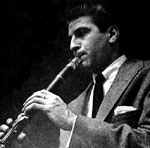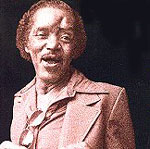Music for Tomorrow | |

| Music to live by- such is the claim in the liner notes to Music for Zen Meditation and Other Joys, as austere and beautiful a record as you'll find. Although it's never quite specified what those other joys might be, the way the music rises and falls in waves of quiet ecstasy leaves fairly broad hints, Made by Tony Scott in Tokyo in 1964, accompanied by Japanese harp (koto) and flute (shakuhachi), and the first example of jazz going to Japan. Quite surprising really, considering how jazz-literate the Japanese are, besides the fact that you can find Gene Clark's No Other or Vince Martin and Fred Neil's Tear Down the Walls over there and not here. Tony Scott, whose real name Anthony Sciacca gives more of a sense of the shock of the new he would bring to clarinet pyrotechnics, is a name you'll find credited on a multitude of sessions from the 50's onwards, bringing his yearning tones to dates with Billie Holiday or Mark Murphy. Branching out into solo work, however, he developed the range which makes his playing keenly exciting, urging the listener to give in to his brand of stentorian strength and satori. Qualities which I admire in the work of Lee Konitz, whose ice-cream cool also has its robust brushstrokes, like all the best West Coast sounds. It partly explains why, for me, the harp lays claim to being as visceral and haunting an instrument as any- not just as an excuse for surreal narcissism by Harpo Marx in his fantasy interludes, but its use by Dankworth gives it a permanent attraction. It's there in those quietly savage punting scenes in Accident, and when I saw his Clarinet Concerto performed recently, lo and behold, those plucked harp strings were featured prominently again, harnessed alongside the scything clarinet with its sweeping echoes of Milhaud, Ravel or Stravinsky in full stride. A work to be proud of, which partly explains why the old man was in attendance on the night- proof that you can be English and make music full of Summery insouciance (ok, Summer where!?) which is also music to watch gangsters by, judging by his work on the soundtrack of Gangster Number One. Or the mysterious case of the harpsichord- a strange instrument to find yoked into the free jazz world, but there it is on Ayler's anguished Love Cry, Another favourite classical piece is the De Falla harpsichord concerto, with its slow stately central movement, establishing a high pitch high tension tightrope feel which never loosens its grip. I'm not sure Sam Fuller spent enough time on the soundtracks to his films to work in harpsichord motifs, but his work is bathed in the same sustained clinical precision, fuelled by taut pulp mechanisms which itch to slap the viewer into reacting emotionally. Those trigger cuts which adorn his journey to Japan in House of Bamboo with its convoluted plot revolving around the local Itchiban or gangster number one, and the inspired casting of Robert Ryan and Robert Stack, granitic gangster faces at home equally in Nicholas Ray or Douglas Sirk melodrama as film noir. The film illustrates Fuller's dictum that cinema is a battleground of emotions, love and hate, piercing gazes, move and counter-move, played out against the decorous backdrops of Tokyo, with a giant carousel on which the final shootout takes place. Godard plundered from scenes like the assassination of later Bonanza star Cameron Mitchell in a barrel, sprayed with bullets, I'm certain. |

| The 1950's were rife with Japanese-American cross-fertilizations. There's Kerouac and the Beats, even Dennis Stock, whose lens was equally at home shooting Cecil Taylor on the enigmatic Looking Ahead! sleeve as it was capturing the wilderness of James Dean's ever-changing moods. Dean comes across now as a maverick Morrissey before his time, all quiff and awkward glasses, meet him at the cemetery gates. Stock ventured out into producing photographs to illustrate those inspired haikus of the nomad Basho during his own journey to Japan following in the poet-monk's footsteps. And of course there's the friendship between Jimmy Dean and 50's seen-and-done-it-all icon John Gilmore. I love the fact that there are two great John Gilmores whom I turn to with equal regularity, the other being the favoured tenor sax man in Sun Ra's early Arkestra. The Hollywood Gilmore is the madcap author of the Black Dahlia murder case (pace Colin Wilson, as gruesome a piece of criminological spadework as you'll encounter, in all its elemental savagery) or the Kenneth Angeresque reverie of Laid Bare, with its unforgettable subtitle A Memoir of Wrecked Lives and the Hollywood Death Trip, drawing gleeful tribute from the likes of Genesis P. Orridge. In its own way the book is as sustained a meditation on the urge to compromise, the fame trip as the necessary precursor of the loony trip, as you'll find. In its deft merging of memory and fact he achieves a sustained improvisation on the off-beat, chapter headings like 'Kiss Tomorrow Goodbye' pointing the way to excess while staking out enough distance from the tumult for me to wish Deleuze or Guattari had had a chance to read it. In my imagination their Anti-Oedipus or A Thousand Plateaus could equally be littered with examples from it, or Alec Empire's sonic terrorism for that matter, as the dubious pornography of Bataille. Turning to someone who never seemed to stray from his own 1000th plateau of aesthetic intensity, Sun Ra's early sounds are as eerie and challenging in their way as you'd expect from the man whose claim to immortality is based on as solid evidence as I've ever encountered. To set the record straight, men are from Mars, Sun Ra will always be from Saturn, and I'm not one to argue. Especially when you set upon the Jazz in Silhouette lp, with its glorious opening track 'Enlightenment'- the surprise lies partly in its relatively easeful harmonic stylings, you can hear echoes of the early birth of the cool synthesis of reeds and brass, nothing too out there on first listening. Listen more closely and awkward dissonances leap out, the band seems to be dancing on a giddy current rather than riding the famous blue notes most jazz has been claimed to rely on. Gilmore seems to wander in and out of shot, his tenor sax given added focus by the lovelorn trumpet cries of Hobart Dotson. There's an artfulness in the subterfuge here which, when coupled with the poetic template of Ra's liner notes ('MUSIC BY THE SUN AND THE STARS OF TOMORROW…/ MUSIC BY THE STARS AND THE SUN…'), shows how unsettling you can be with the barest of raw materials. Strange, stranger to himself, strange angels shooting arrows through quivering harp-strings. |

| Time to return to enlightenment Tony Scott-style, no stranger to exploration himself, whose pioneering approach to others' compositions is worth mentioning. He'd rather take a standard and subject it to multiple fracturings, recasting the familiar in more oblique and disconcerting fabric in order to return the freshness of invention. What better way to pay tribute to the timeless melancholy of Strayhorn's 'Lush Life' than reinvent it utterly. Not once but on several lp's worth of inventive improvising around the composition. As if trial by jury was lacking in substance- twelve angry men, no, too easy to let something slip through the gauze of perception. The trial here is more akin to Josef K's endlessly deferred endlessly self-defeating internal strife, filtered through mock ritual and mocking close-up detail. This sort of hallucinatory through the looking glass approach to music-making, with every detail pondered and explored before it settles into the kaleidoscope world it emerged from, is endlessly intriguing. To borrow from the other Josef K, (I know I've borrowed from both before, but this is not self-parody, not just yet) there's endless soul here. There's a strange moment of recognition in the Percy Mayfield song 'My Blues' which achieves something similar for me. A moment arrives which anticipates a direction merely suggested but never quite pursued, and looks backwards to a more simplistic and recognisable form of street song. His blues are of the most majestic, tortured and openly heartfelt imaginable- suddenly there's a piano sleight of hand which turns into a syncopated echo of the main theme, hinting at resolution in a cabaret theme but slyly reverting to darkness and discord. Percy's troubled waters are as down-at-heel as anything in the world of David Goodis, and I love the fact that the piano player's moment of attempted scene-stealing echoes the theme played by Aznavour in Tirez Sur le Pianiste. Aznavour's barroom improvising, the pianola played in the style of his undersung hero Junior Mance, is unerringly graceful- his is music to drink, smoke, shoot pool or indulge any other kind of nocturnal activity by, so poignant it hurts. Yet Aznavour of course plays music to lose it all by- virtually every scenario he played or sang invites you to imagine someone who had it in the palm of their hands… until it slipped- Zoff's Italian team, throwing away a one goal lead with seconds of injury time remaining. Goodis's world is sustained by shoestrings, a barrel organ and the barrel of a gun, ingredients which also make Mayfield's music justly revered and fearless enough to give any late-night DJ the jitters. Play 'Misty' for me? Maybe, but 'Kiss Tomorrow Goodbye' or 'Life is Suicide'? Naked pain amid the black snake blues… ©Marino Guida 2000 |